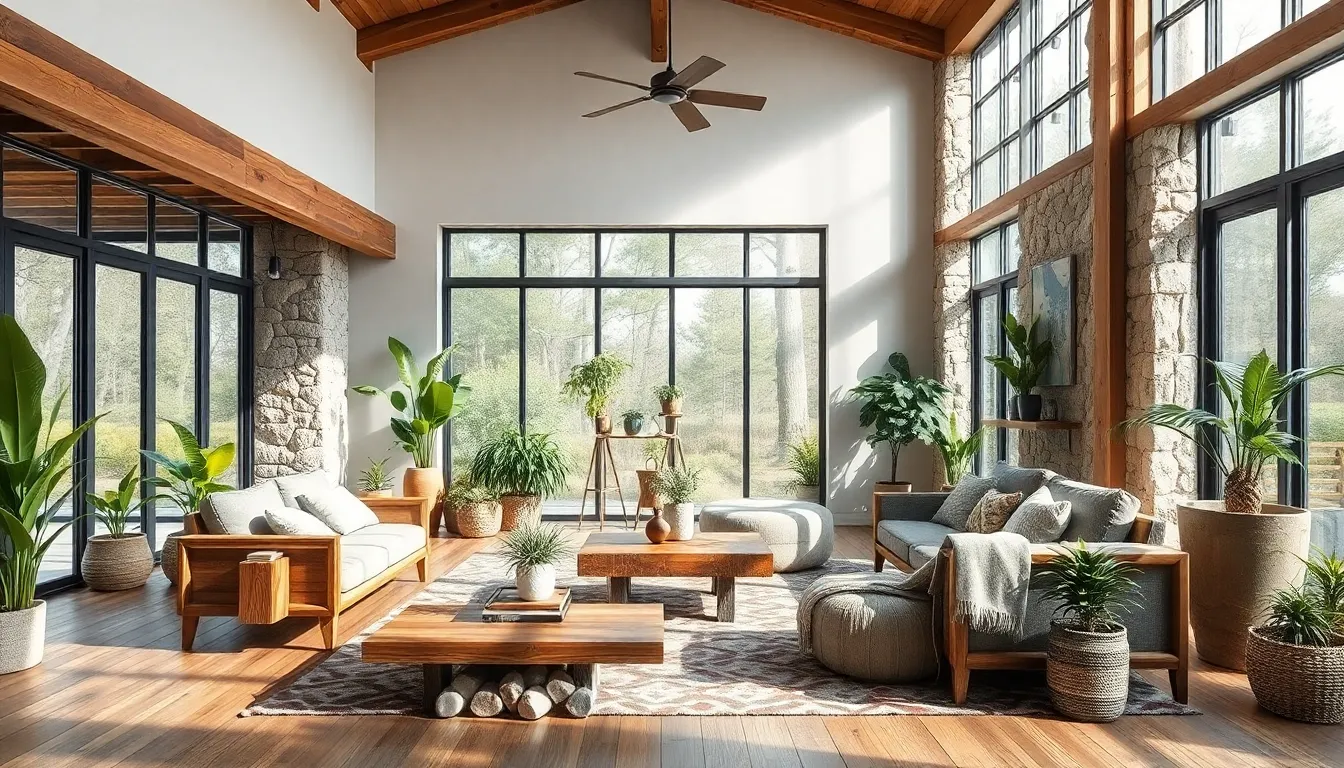In a world where urban living often disconnects individuals from nature, biophilic home design emerges as a transformative solution. This innovative approach integrates natural elements into residential spaces, fostering a sense of harmony and well-being. By incorporating features like natural light, greenery, and organic materials, homeowners can create environments that not only look beautiful but also enhance mental and physical health.
As people increasingly seek refuge from the chaos of modern life, biophilic design offers a refreshing perspective on home aesthetics. It champions the idea that our living spaces should reflect the beauty of the natural world, promoting relaxation and rejuvenation. Discover how embracing biophilic principles can lead to a more sustainable and fulfilling lifestyle, turning any home into a serene sanctuary.
Table of Contents
ToggleWhat Is Biophilic Home Design?
Biophilic home design integrates natural elements into residential environments, fostering a connection with nature. It emphasizes sunlight, greenery, and water features to improve well-being. This design philosophy taps into humans’ inherent affinity for the natural world.
Key components of biophilic home design include:
- Natural Light: Maximizing daylight through large windows or skylights enhances mood and productivity.
- Indoor Plants: Incorporating a variety of plants purifies the air and creates a calming atmosphere.
- Organic Materials: Utilizing wood, stone, and other natural materials adds texture and warmth to spaces.
- Water Features: Including fountains or aquariums promotes relaxation and tranquility.
- Nature-Inspired Colors: Using earth tones and botanical hues connects interiors with the outdoors.
Biophilic design promotes sustainable practices by encouraging energy-efficient solutions and reducing environmental impact. This approach transforms urban residences into restorative spaces, offering a reprieve from city life. By embracing biophilic principles, homeowners create sanctuaries that nurture both body and mind.
Key Elements of Biophilic Home Design

Biophilic home design focuses on integrating nature within living spaces. This approach not only enhances aesthetic appeal but also improves mental and physical well-being.
Natural Materials
Natural materials play a crucial role in biophilic design. Wood, stone, and bamboo create warmth and texture. These materials often promote sustainability by being renewable and biodegradable. For example, using reclaimed wood contributes to reducing waste while adding character to interiors. Additionally, stone accents can evoke a sense of permanence and connection to nature.
Light and Space
Light and space significantly influence the ambiance of a home. Maximizing natural light through large windows increases comfort and reduces reliance on artificial lighting. Skylights and glass doors also enhance openness, blurring the lines between indoors and outdoors. Strategic layout design further allows for a flow of air and movement, enhancing a sense of spaciousness.
Indoor Plants
Indoor plants enhance air quality and add life to living spaces. They provide aesthetic appeal while offering psychological benefits, such as stress reduction. Specific plants, like peace lilies and snake plants, are known for their air-purifying properties. Incorporating a variety of plants throughout different areas of the home creates a dynamic environment that evolves with the seasons, fostering a deeper connection to the natural world.
Benefits of Biophilic Home Design
Biophilic home design offers various advantages that enhance both the living environment and the residents’ overall quality of life. Key benefits include improved well-being and enhanced creativity.
Improved Well-Being
Improved well-being stems from exposure to natural elements, which significantly reduces stress and anxiety levels. Studies show that inhabitants of biophilic spaces experience lower blood pressure and heart rates. Incorporating indoor plants also purifies the air, removing toxins and improving respiratory health. Natural light boosts mood and increases serotonin levels, creating a more positive atmosphere. Access to outdoor views fosters a connection to nature, promoting relaxation and enhancing mental clarity.
Enhanced Creativity
Enhanced creativity is another benefit associated with biophilic design. Environments rich in natural elements inspire innovative thinking and problem-solving. Research indicates that exposure to greenery stimulates cognitive function, leading to increased focus and productivity. Dynamic spaces that blend nature with design inspire imaginative processes, allowing for a clearer mind. Natural light influences the circadian rhythm, improving sleep patterns and overall mental acuity, which supports creative endeavors.
Tips for Implementing Biophilic Home Design
Biophilic home design fosters a connection to nature, creating healthier living environments. The following tips detail how to effectively integrate natural elements and light into interior spaces.
Incorporating Natural Elements
- Use Indoor Plants: Choose a variety of indoor plants, such as pothos and ferns, to enhance air quality and aesthetics.
- Select Organic Materials: Opt for materials like bamboo and reclaimed wood. These materials provide warmth, texture, and sustainability, reinforcing the connection to nature.
- Add Water Features: Include small fountains or aquariums to introduce the calming effects of water, which creates serene spaces and adds soothing sounds.
- Choose Nature-Inspired Decor: Integrate decor items that reflect natural forms and colors, such as stone sculptures or leaf-patterned textiles, enhancing the overall theme of natural integration.
- Create Views of Nature: Position furniture to maximize views of outdoor landscapes. This connection can promote relaxation and restore energy.
Maximizing Natural Light
- Install Large Windows: Use expansive windows to flood interiors with sunlight. This creates a bright atmosphere that energizes spaces and occupants.
- Incorporate Skylights: Add skylights to draw in additional daylight, creating an open and airy feel while inviting a dynamic play of light and shadow.
- Utilize Open Floor Plans: Design layouts that promote airflow and visibility between spaces, allowing light to travel unobstructed throughout the home.
- Choose Light-Colored Walls: Opt for light paint or finishes to reflect natural light, amplifying brightness and enhancing the illusion of space.
- Install Mirrors: Strategically place mirrors to bounce light around rooms, maximizing the effects of sunlight and enhancing the sense of openness.
Biophilic home design offers a transformative approach to urban living by reconnecting individuals with nature. By incorporating natural elements into residential spaces, homeowners can create environments that nurture both mental and physical well-being. The benefits extend beyond aesthetics; improved air quality and reduced stress levels contribute to a healthier lifestyle.
Implementing biophilic principles not only enhances creativity but also fosters a sense of tranquility in daily life. As individuals embrace these design strategies, they cultivate serene sanctuaries that promote relaxation and sustainability. Ultimately, biophilic design isn’t just about building beautiful homes; it’s about creating spaces that enrich lives and restore harmony with the natural world.





